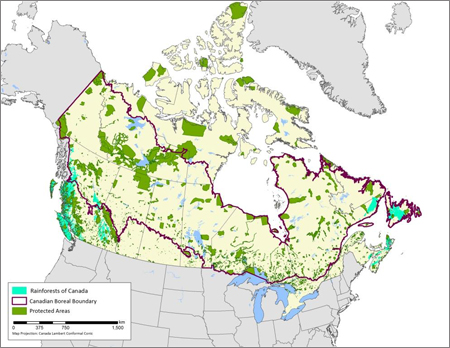A new book to be released this fall and announced today highlights a special type of forest found in ten regions around the world. This forest type—termed by the book’s authors as “temperate and boreal rainforests”—are essentially forests that receive high levels of precipitation but, unlike tropical rainforests, these forests are in high latitudes where the temperature remains cool. Most of these forests are also found near coastlines.
The term “boreal” is used by the book’s authors to describe the northernmost of these rainforests. Some of these unique forest habitats occur within the vast six million km2 (1.4 billion acre) ecoregion known as Canada’s Boreal Forest within British Columbia, Newfoundland, and Quebec as shown in the accompanying map.
These northern rainforests store and hold massive amounts of carbon and they along with other northern ecosystems like the expanses of peatlands, spruce, aspen, pine and fir forests, taiga, deltas, lakes, and tundra within Canada’s Boreal Forest have been largely overlooked by policy makers considering climate change issues and solutions. In fact, Canada’s Boreal Forest region is estimated to hold at least 208 billion tonnes of carbon equivalent to 26 years worth of the CO2 emissions as measured in 2006. A report released in 2009 (The Carbon the World Forgot) details the importance of Canada’s Boreal Forest for mitigating and adapting to climate change.
In Canada, only about 12% of the Boreal Forest region and an even smaller proportion of these rainforests are included within existing or interim protected areas. But because these rainforests occur within still intact regions of Canada’s Boreal Forest, the possibility of protection remains a viable option as land use decisions continue to be made. A visionary model developed by a coalition of Aboriginal governments, conservation groups, and industry has been proposed for ensuring the future of these rainforest habitats and the myriad other special places within Canada’s Boreal Forest region. That model—called the Canadian Boreal Forest Conservation Framework---calls for establishing protected areas encompassing 50% of the Canadian Boreal Forest region with leading edge sustainable development practices in place in the remaining lands. In Quebec, where one of the rainforest habitats occurs on the north shore of the Gulf of St. Lawrence, the Premier pledged to protect 50% of the region from industrial development. The implementation of that pledge, called the Plan Nord, is well underway and should include protections for regions like this rainforest habitat as well as many other special habitats found with Quebec’s Boreal Forest. Meanwhile in Ontario the provincial government recently passed legislation to establish a land-use planning process with First Nations that ensures protections for as much as half of that province's Boreal Forest region. The provinces of Newfoundland and British Columbia which both have significant rainforest habitats, have as yet, not made similar commitments for protection of their important habitats.



